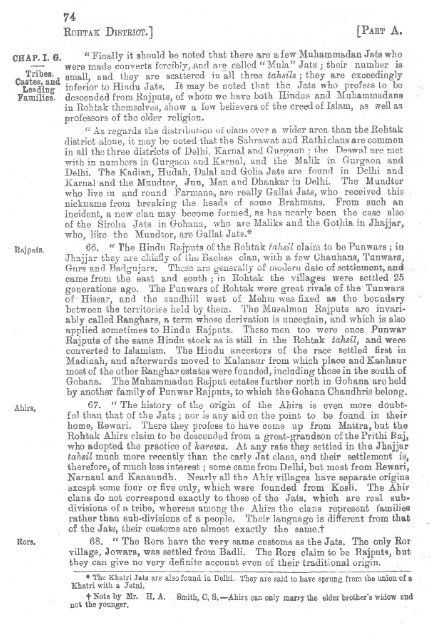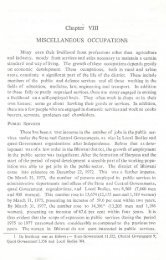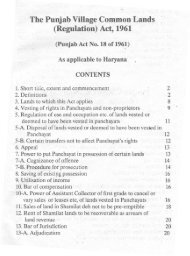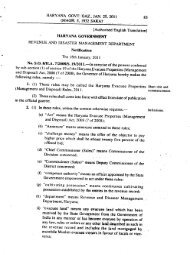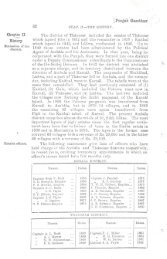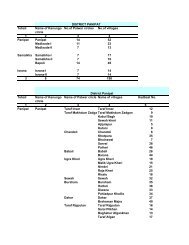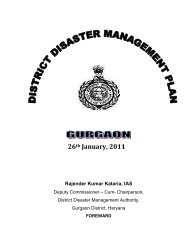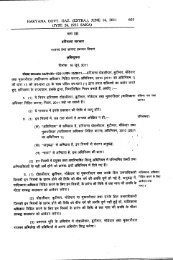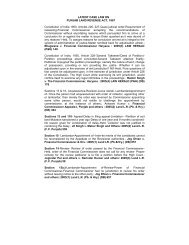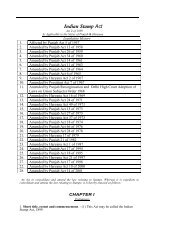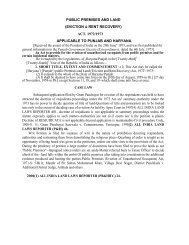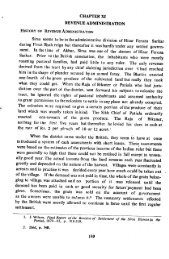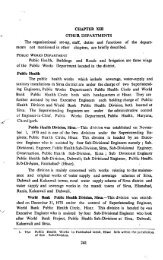chapter - iv - revenue and disaster management department, haryana
chapter - iv - revenue and disaster management department, haryana
chapter - iv - revenue and disaster management department, haryana
Create successful ePaper yourself
Turn your PDF publications into a flip-book with our unique Google optimized e-Paper software.
74RORTAK DISTRICT.]CHAP.I G. rcFinally it should be noted that there are afewMuhamma.dan Jats who-' were made converts forcibly,.<strong>and</strong> are called" Mula" Jats j their number isCTrbes'd small, Bnd they are scattered ina.ll three tahsils ;they are ex:ceedingly~e:d'~: inferior toHindu Jats. It may be noted that th~ Jats who profess to beFamilies. descended from Rajputs, of whomwehave both Hmduil <strong>and</strong> Muhammadansin Rohtak themselves, show a fewbelievers of the creedofIslam, as wellasprofessors of the older religion.aAsregards the (hstrllJution ofclansover a wider area than the Rohtakdistrict alone, it may be noted that the Sahrawat <strong>and</strong> Rathiclans are commonin all thethree districts of Delhi, Karnal <strong>and</strong> Gnrgaoll ;t.he Daswal are metwith in numbers in Gurga,ol1<strong>and</strong> KRl'na], <strong>and</strong> the Malik in Gurglwn <strong>and</strong>Delhi. The Kadian, Hudah, Dalal <strong>and</strong> Golia Jats are founn in Delhi <strong>and</strong>Karnal <strong>and</strong> the Mundtol', Jnn, Man <strong>and</strong> Dhankar in Delhi. The Mundtorwho l<strong>iv</strong>e in <strong>and</strong> round Farmana, are really Gallat Jats, who rece<strong>iv</strong>ed thisnickname from breaking the heads of some Brahmans. From such anincident, a new clan may become formed, as has nearly been the case alsoof the Siroha Jats in Gohana, who are Maliks <strong>and</strong> the Got.hiain Jhajjar,who, like the Mundtor, are GallaLJats.*R/ljputs. 66. U The Hindu Rajputs ofthe Rohtak tahsil claim toboPunwal's ;inJhajjar they are chiefly of LhtlBachas clan, with a few Ohauhllons,Tunwars,Gurs <strong>and</strong> Badgujars. ThcsBare generally of illoJel'l1 date ofsettlement, <strong>and</strong>came from the east <strong>and</strong> south; in Rohtak the villages were settled 25generations ago. The Punwars ofRohtak were great r<strong>iv</strong>als of the Tunwarsof Hissar, <strong>and</strong> the s<strong>and</strong>hill wast of Mehm was fixed as the bo&odarybetween the territories held by them. The Musalman Rajputs are invariablycalled Ranghars, a term whose der<strong>iv</strong>ation isuncelltaiD,<strong>and</strong> which isalsoapplied sometimes to Hindu Rajputs. These men too were once. PunwarRajputs ofthe same Hindu stock as isstill in the Rohtak tahsil, <strong>and</strong> wereconverted to Islamism. The Hindu ancestors of the race se~tled first inMadiaah, <strong>and</strong> afterwards moved to Kalanaur from which place <strong>and</strong>Kanhaurmostofthe other Ranghar estates werefOllnded,including those inthe south ofGohana. The Muhammadan Rajput estates further north in Gohana areheldby another family ofPunwar Rajputs, towhich the Gobana Ch<strong>and</strong>hris belong.AmI'S, 67. If '1'hehistory of the origin of the Abirs is even more doubtfulthan that ofthe Jats ; nor isany aidonthe point to be found in theirhome, Rewari. There they profess to have come up from Mattra, but theRohtak Abirs claim to be descended from a great-gr<strong>and</strong>son ofthe Prithi Raj,whoadopt'ed the practice of karewa. At any rate they settled in the Jbajjartahsil much more recently than the early Jat clans, !lndtheir settlement is,therefore, ofmuchlessinterest j somecamefromDelhi, but most from Rewari,Narnaul <strong>and</strong> Kanaundh. Nearly all the Ah1rvillages have separate originsoxcept somefour or f<strong>iv</strong>eonly, which were founded from Koali. The Abirclans do not correspond exactly to those of the Jats, wbich are real subd<strong>iv</strong>isionsofa tribe, whereas among the Ahirs the clans represent familiesrather than sub-d<strong>iv</strong>isions of a people. Their language is different from tha.tof the Jats, their customs are almost exactly the same.tRors. 68. "The Ror8 have the very same customs as the Jats. The onlyHorvillage, Jowara, was settled from Badli. The Rars claim to be Rajput9, buttbElYcan g<strong>iv</strong>e no very definite account even of their traditional origin. .• The Khatri Jats are also found in Delhi. They are said tohave sprung from the union ofaKhatri with a Jatni.tNote by Mr, H. A. Smith, C.S.-Ahirs canonly marry the elderbrother's widow <strong>and</strong>no~theyounger.
lWUTAK~DISTRICT.J75[PART A.69. tlTheBrahman villages, ashas been said, generally separated from CHAP. I, G.some adjoining Jat or other estates; only four have had an existence longer T 'besthan 13 generations. But it was an invariable hClbit for Jat settlers to Caiies indbring Brahmans with them, <strong>and</strong> in many cases, therefore, their residence is Lea~(ng;.....a8ancient asthat offhe former. The Brahmans of the whole country-side Famlhes.- are said to belong to the great Gaur sub-d<strong>iv</strong>ision of the race. Sir George Brahman9.Campbell has conjectured that they are, perhaps, not a branch of the Gaurtribe of Bengal, but, that their name may have been der<strong>iv</strong>ed from their residenceon the Ghaggar. The commonest clans are the Bashisht <strong>and</strong> Gurin Jbajjar; the Mihrwal, Dabra <strong>and</strong> Bharad-dawaj in Gohana, <strong>and</strong> theKoshish, *70. c:The Gujar villagos also are all of recent origin, none dating back Gujar9.further than eight generation;;;. The Karaua ana Kathana clans are tiletwo commonest <strong>and</strong> these are also found in Gurgaon :the latter isthe chiefclan in Gnjrat itself.71. "The Afghans of Gohalla are Kakarzai, <strong>and</strong> of Guriani Naghar- Afghan9.Ghargast-two sub·d<strong>iv</strong>isionsofthe great Kakar tribe whichlies eastofPeshin;the people are probably quite unaware of their relation toeach other. TheJhajjar Pathans areEusafzai from the well-known valley in Peshawar: noneof the Afghans have been settled in the district more than 14genel'at.iom~.'72, "The Bilocheg are of 1mknown. Eub-d<strong>iv</strong>isions; the oldest estate .DU0chGs.was founded only 10generations back./( 73. It The Sheikhs are Koreshis, <strong>and</strong> the Sayads) Roseinis; the MiscellaneousKaiyaths are ofthe Kanungo <strong>and</strong> other familiest in Government service, owners.<strong>and</strong> the Mahajans areall proprietors with new titles. The other ownerscall for no notice here. "'"74. To the above account by Mr. Fanshawe of the origin of D<strong>iv</strong>isio~ ofthe tribes there is little information to add beyond what has been tkhhae.g<strong>iv</strong>en in the footnutes. There is,however, one noteworthy omis..tions.sian; Mr. Fan~hawe has noticed the strong tribal organization;athwart this runs avery curious d<strong>iv</strong>ision into lchap orfactions, whichhas been noticed by Sir D. Ibbetson in paragraph 190 of his KarnalSettlement Report. The two chief factions of the north of the dis..trict are the Dahiya (which includes others besides the tribe oftha.t name) <strong>and</strong> the Haulania faction, which is headed by theMalik Jats <strong>and</strong> takes· its name from Ahulana. The struggle forsupr.emacy between these two factions is still very marked, Bndled in 1909-10 to cODsiderable bitterness when the Haulanias-~ opposed the proposal of the Dahiyas to bold apanchayat to reducethe Nais' fees <strong>and</strong> to reguhte marriage procedure for the wholecountry-side. Each party was jealous ofthe other, <strong>and</strong> the Dahiyafaction retaliated by boycotting-the leaders of tbe Haulania. Geographicalnecessities occasionally mudify the natural d<strong>iv</strong>isions: for• There is aninferior class of Chamarwa Brahman who ministers to Chamars. These arenot agriculturi~t8. Oampare the Dakots. G~jratis, et~. . .tThe KaIa8ths say they are Kshatnal\. aclatm that seems well founded-0$-.Tal'lkh-l'Akwam by Mr.J. G. I\eufeld <strong>and</strong> published by order of the Government ofIndia. Home Depart.ment, Circular No. 4-119 to 128. dated 2lst September 1885 at Allahabad Press. Hindu Ll\wofSucce.sion by Ba.buRaj Kumar, B.A., p. 9
76BORTAK DISTBIOT.]CRAP. I, G.example, the isolated Malik villages of Anwli, Bilbilan, Riwara <strong>and</strong>oT~ibe8. Jasram~belong to the ~actjon of the surrounding DahiyaB. Self-Castes, a.nd protectIOn dem<strong>and</strong>s thIS.Fa.milies, Leading Q"l t..:Jlmlar Of actIons • d' IVl 'detea h K d' lans, JakharB, G}' 0las, Db°ankarB,<strong>and</strong> other chief tribes of the sout.b, <strong>and</strong> in intrpducing the gradt'dzaildari system in 1910 the opportunity was taken of alteriug thezait boundaries to suit the factions, for the influence of a zaildarin a villflge of an opposite faction to his own extends only 80 farasthe strong arm of the execut<strong>iv</strong>e supports him.Genera~ . 75. Several of the Jat tribal names suggest a totemistic~r%~c~:::.IJCS origin. Such are the Machhar (moaquito), Jlln (louse), Chikara.(gazelle), Mol' (peacock). Similarly, the Ahirs have a Sanp (snake)got.In appearance the people ofthe district are distinctly Hindustanis,their faces reflecting, as Mr. Fanshawe noted, the warmcolour ofthe soil they till. The Jats are generally of very finephysique, <strong>and</strong> the younger women often comely. fJ'hough it ishardly possible to identify aman's tribe by his features it is ofteneasy to see tbat one of a group oflambardarR in a village is of adifferent got to his fellows. From the southern part of the districtwhere the demanJs alld profits ofagriculture are less then inthe irrigated north a larga number of Jats enlist in the cavalryor infantry. They make bl'ave, but not particularly intelligent,soldiers. The Jat is slow to grasp a new idea, <strong>and</strong> while independent<strong>and</strong> democratic will generally follow his leader like a sheep.For patient industry <strong>and</strong> endurance as an agriculturist he has fewequals. If a Jat dol'Snot pay his <strong>revenue</strong> iLis usually a sure sign'"that there is nothing with which to pay it. He is lord of thel<strong>and</strong> <strong>and</strong> when asked who he is, replies" zamindar," berore he says"Jat." They"are very clannish <strong>and</strong> cherish the memories ofanoientfeuds. n is a common saying in certain villages that they stillhave their neighbonrs' shoes with whioh they beat them in thelawless days of 1857. They are shrewd, <strong>and</strong> love a joke, wbenthey master it. 'fheir proverbs are full of wisdom, often at theirown expense, for example :-"Soil, fodder, clothes, hemp,munj, <strong>and</strong> silk,these sixarebestpound~d,s6venthly the Jat."The Jat as,would be expect.ed, is orderly <strong>and</strong> law-abiding as arulf', but bis temper is quickly rousted,<strong>and</strong> crimea of violence areDotuncommon.The Jatni is her husb<strong>and</strong>'s helpmeet. She does every kind offield labour except dr<strong>iv</strong>e a plough or cart <strong>and</strong> work a well., Sheis in accition to this a capable housewife. It is noteworthy thatmany ofthe Jats' proverbs take the forIQofa conversation betweenhim <strong>and</strong> his wife. To her importance the following proverB bearswitness: "Red rice, a buffalo's milk, athrifty woman at home, <strong>and</strong>
RoHTAK DrS'flUOT.]17[PART A.a borae to ride, these are heaven's four marks; bad bread, agoat to ellAP. I,G..milk, a shrew in the house, <strong>and</strong> dirty clothes, these are the four Tribes 'I·signs ofbelL" Ct~na.~d .76. The Bors rank with the Jah; whom they closely resemble. Familils.The Ahirs are perhaps superior even tothe Jats inp~tieDt <strong>and</strong>skilful Generalagriculture. L<strong>iv</strong>ing as they do in the s<strong>and</strong>y part ofJhajjar where characterist~csth II I I 1. . 1 d ofRors Ahirsewe rnnne sare SO por'ons tlnt tJey reqUIre to be pastere <strong>and</strong> Brah.each time they are used, their resoUl'cefuIness has been more de- mans,veloped than that of the J-ats. The common ~aying: Kosli I.·aAhi7',kheti ki tadb£r-" TLe A.LirofKosIi, the craft ofagriculture," showstheir repntation. Like the Jats they practice wioow marriage.Their women may always be known by their bllle petticoats, <strong>and</strong>red orhnas worked on the hem in white. The proverb: Bawanbangle Kosli aur banke kai haza,r-" Kosli has 50 :3tone'houses <strong>and</strong>several thous<strong>and</strong> swaggerers," rshows that t.be surrounding Jatsare somewhat jealous of them.The Brahmans are inferior cult<strong>iv</strong>ators to the Jats; thonghthey have ab<strong>and</strong>oned tue strict rule that requires tbem to eat theirfood where it iscooked, their women lZ<strong>iv</strong>elittle 01' no assistance inthe fielqs beyond bringing their meals. They are often prohits.as well as cult<strong>iv</strong>ators <strong>and</strong> are £1pt to fall between two stools. Mr.Fanshawe noted that. they al'e better cult<strong>iv</strong>ators in a Jat villagethan in a Brahman-owned estate. 1'hough respectt'd by the peuple(the village of Wazirpul' iscalled Dadau, from Dada, the'"reverelltialmethod of addressing a Brahman) they are pilloried inthe proverbs" Kdl bdga7'se upje, burc{, B(dm~anse ho"-," Famine comes fromthe Hagar as evil from a Brahman" ;<strong>and</strong> again, "one may escapedeath, but not the Brahman."77. '1'heMuhammadan Rajputs have been described as "good General,ld ' d' dOff . h Ir 1" tI 1'£ character18-so ler8an m I erent cultIvators w oserea Jm'te 18S10 cat e- I t-·tics of theing." '1'beyare certainly feckless farmers, general1y preferring to Rajputs.let their l<strong>and</strong>s rather than till them in person. The first breath ofthe storm that bends the Jc\tbreaks the Ranghar. -In truth, agricultureis only the second string to their bow, military' service beingthe firat. The Rajput circle of the Rohtak ·tahsil assessed atRe. 52,000 has an annual income ofRs 4,62,4UO horn service <strong>and</strong> pensions.The criminal reputation of these Rajpllt villageoisinfamous.The conduct oftbis tribe in t.hemutiny bas been alreadymentioued.It was aRmgbar of Kflnhaur wbo shot Major Neill in 1887.The tribe has tbB worst possible repntation among the people ofthe country-side with whom the common saying 1s:- .UKulta billi d", Ral1ghar G1ljal' do,Jib yeh rlHtronna hon, lch~tlekowanin so." .f,The "dog <strong>and</strong> the cat are a pair, <strong>and</strong> 80are· the Ranghar <strong>and</strong>'Gujar; wh~n these four al'~not about~open your doors to eleev.~'.
78ROHTAK DISTRICT.]CHAP. I, G. It is said that a Jat will not go alone at night to a RangharTribes, village. They quote :-Ca.e.tes.•<strong>and</strong> "Gnia1' godd J'.int ·/·ar bar ':Ji'1Jalsikh,1'antLeading 'J , .' r ,Famili~s. Ranghal' hdrajibjaniyo, nllinal/' ni1'dhalant.""Yon may know a Gujar done for when he'a lamed, aJanf when itdries from the root, a ba?' <strong>and</strong> pipal from the top. Know aRangbar beaten when the rheum of age flows from his eyes" ;again "A Ranghar is best in a wine shop, or ingaol, or in prison,or in the gra'\Te."Their reputation as <strong>revenue</strong>-payers is shown in the followingproverb:- -"Dehli se paintis ko~Kallham' Niganah,Apnci boya ap 7chawen hakim ne nahin dewen ddnd."" From Delbi 35 miles are Kanhaur <strong>and</strong>' Niganab. Thoyeatwhat they sow <strong>and</strong> pay Government never a gmin."rrbe Hindu Rajputs combine all that is best in the Rajputwith what is least admirable in the Jat.Characteri6- 78. rr'heAfghans <strong>and</strong> Pathans are bad cult<strong>iv</strong>ators, generallytics of Af- in debt <strong>and</strong> often dissolute. 'l'hey make good soldiers. The Guriani~~~~s Pathans add alittle D.orse-copiug to their other means of subsistaBilo?hes: ence. They are very bad <strong>revenue</strong>-payers. The' Hi/oches are poorg:;:~~,cult<strong>iv</strong>ators <strong>and</strong> heavily indp.bted. Like the.Ranghars <strong>and</strong> otherShelrha a~d Muhammadan tribes their womenkind are aburden tothem insteadSaiyads. of an assistance. The Gujars are ranked with the Ranghars bythe country-sid a,lmt are really su!wrior to them as farmers <strong>and</strong> farless criminal. '['he DogRrs J<strong>iv</strong>eill Parah, asuburb of Rohtak, <strong>and</strong>are much like their neighboul's, the Juts. 'TheShekbs of Rohtak,Jhajjar <strong>and</strong> Mehm are bad cult<strong>iv</strong>ators, quarrelsome <strong>and</strong> litigious.The Saiyac1gof Kharkhauda with their interminable family feuds<strong>and</strong> intrigues are a perfect nuisance ill the administration ofthedistrict.The notifi. 7~: The tribes notified as agricultural under theL<strong>and</strong> Alienaet:J:.{/cuttur.tion Act(XIII of HIOO) in the district are Ahir, Biloch, Gujar, Jat,a n ea. Mali, Moghal, PaLhal1,Rajput, Hol', Saiyad, <strong>and</strong> Gaur Brahman,(excludi.ng Bohrns); ofthese the, ,first. en form one group, <strong>and</strong>the Gaur Brahmans have been notJfie(l Jl1 a separate group withtheir fellows in Gurgaon, Delhi nnd Kamal districts, <strong>and</strong> theFattehabad, Hansi <strong>and</strong> Hissar tahsils ofthe Hissar district.Non,agricul. 80. Ofthe non-agricultural tribes the Chamars are far themost~uraUribes, important, <strong>and</strong> they almost deserve to be called agriculturaL Notonly is their trade essential to rihefarmer, but they g<strong>iv</strong>e agreatdeal of a8sistance, either in retum for a share of the crop, or asday-labourers in the actual processes of agriculture, while it isvery oommon to find them associated in cult<strong>iv</strong>ation as sanJhi
~9[PARTA.<strong>and</strong> d<strong>iv</strong>iding the profits. It is becoming, too, more <strong>and</strong> CHAP. I,G.more common for them to cult<strong>iv</strong>ate independently as tenants. Tribes ;.With the growing dem<strong>and</strong> for labour due to the expansion ofthe Castes. <strong>and</strong>country <strong>and</strong> the ravages of plague the customary position ofthe ';a~Wi~f.Cbamar is tending to g<strong>iv</strong>e place to contract. Quarrels betweenthe Jats <strong>and</strong> their menials are increasingly comm'on <strong>and</strong> each side ismore apt to claim its dues than to fulfil its obliga.tions. The Cha·mars belong to a large number of tribes; of which the Chahal <strong>and</strong>the Suhal are the commonest; they follow the eudogamous rules ofthe Jats. '1'heynsually worship the goddess :M:ata~l11d burn theirdead as do the Dhana"ks <strong>and</strong> Kahars. '1'hey are reckless findimprovident" <strong>and</strong> usually very poor. The carcases of dean animals,<strong>and</strong> ihe frllits of the Jal tree alone st<strong>and</strong> between them aud starvationwhen the crops fail. The Dhanaks <strong>and</strong> Chuhras, who are notoften found together, are the village scavengers, whilethe Dhanaksusually weave as well. Khatiks or tanners are found in a few villages.The Knmhnrs (pott9rs), Cbhipis (tailors <strong>and</strong> dye-stampers),Jhinwars (water-carriers <strong>and</strong> molasses-cooks), Telis (oilmen), curpenten(who are usually Khatis <strong>and</strong> sometimes Barhis) anG':Lahars(blacksmiths) are the other important menial <strong>and</strong> non-agriculturisttribes.B .81. sMost o&fthe h 8etribfes as well aSh' the lProrfef:sionallclastesbliS of~~~~~Vsf:~~antyas, '1.t'1'!a')'8, c., ave 0 ten to pay eart 1 eef(,usua y at t eprofessionalrate ofRs. 2pSI'hearth pel'annum to'the village propri'etary body. elasses,Technically there is adistinction between the hearth feeRpaid bymenials <strong>and</strong> the professional tax (tmf-ahtrafi) paid 'by traders <strong>and</strong>artisans though both are levied at the same rates <strong>and</strong> in the sameway <strong>and</strong> loosely grouped togethet· as hearth fees.The liability to hearth fees or tmj does not constitute themernal. Mr. Fanshawe (paragraph 84 of his Settlement Report)rightly defined a menial as "one who for certain clearly defined.regular services rece<strong>iv</strong>9s certain well-known regular dues." Astatement showing the services <strong>and</strong> dues of the menials will befound in paragraph 162. As a mattpr offact a large number ofvillages which recorded the existence of this cess in 1879 havenever exacted it <strong>and</strong> an attempt .has been made in the recentsettlement at greatet' definition on thi~ matter. Even where thetax islevied there are often dispntes as to payment by ind<strong>iv</strong>idualfamilies. It is claimed that a menial or trader who becomes aproprietor with rights in the common is ipso facto exempt,but the Jat does not admit that. The exemption is claimableonly if the householder has acquired the proprietary right of theactnal gronnd on which his house st<strong>and</strong>s.82. The trading class consists generally of Mahajans or Raniyas Trading(root banaj=trading) locally called Bakal. There are, however, in classes, &C.many villages a few Bohra Brahmans, who are un<strong>iv</strong>ersally regarded
80RoRTAK DrSTRlOT.]CRAP. I,G.as the last resort of the creditless horrower. Most ofthe Maha-•.. Tribes. jane are Vaishna:ris, but in Rohtak <strong>and</strong> Gohaoa there are coJoniescastes. a.nd of Saraogis or Jams.LeadingFamilies.The butchers of Rohtak, :M:ehm <strong>and</strong> Gohana, who often combinethe more inoffens<strong>iv</strong>e trade of market gardening, are notoriousfor their quarrelsomeness <strong>and</strong> violence.~me less 83. .The following notes on some of the tribes ofwhom leastkDOW~C3ste!l,isknown were prepared by Mr. H. A.Smith, C.S.Tells.CITelis in this district ~r(l alm03t all Muhammadans. but at the lastcensus30out of7,248 returned themselves as Hindus. The Tunwar gotclaim Rajput descent<strong>and</strong> the Dahima got a Brahman descent. Theil' gotsnever havelocalnames. Theirobjects of worshipare very various. Someworship Khawajn" the Pir of Ajmer, some BabaHassn <strong>and</strong> someBoaliKal<strong>and</strong>ar of Pauipat."The panchayat ofthe Telis is an ancient institution. Each localgroup of Telis has its chattdh1'i <strong>and</strong> he has powerafter consulting thepanchayat toexcommunicateorotherwise puTlishmembersofthe tribe."No outsider canbecomeaTeli..The Dhats. "84. Onlythe Brahtna Dhats arefoundinRohtakoutorthe four classesinto which the Hindu Bhats are d<strong>iv</strong>ided. They 8.re endogamons <strong>and</strong>wear the janeu They willonly eatfood cooked byBrahmans, AgO'arwalMahajans or thomselves,<strong>and</strong> they forbid widow re-marriage. Th~y arein fact.closelyakin to the Bra.hmans<strong>and</strong> call themselves Gaur Brahmans,following the rites of this body on ceremonial occasions. Thestory of their origin suggests Brahman authorship. On one .occasionBrahma wisbeu to g<strong>iv</strong>e an alms (dan). No 'Brahman, howeverwouldaccept alms,<strong>and</strong> finallya sister's sonofa Brahman was found wh~agreed todoso. His descendants are.called Bhats.ifT~ell'function istoflingsongsonoccasionsoffest<strong>iv</strong>ity, <strong>and</strong>tosnmmonmournera from distant villages to take part infunerals. Bhats are alsolearned in the genealo ies oftheir patrons, who iuclude Brahmans <strong>and</strong>Mabajans ooly.* There are 300Hindu Bhats inthe district. There isasmallcommunityviMuhammauan Bhata inGohana-30 in nuniber-who donot follow Brahman cnstoms. They represent three groups-Bejlan, LilSaha <strong>and</strong> Gur Deva. Theil' duties are more extens<strong>iv</strong>ethan thoseoftheHindu Bhats-,forthey assemblethe bratherhoqd for marriages, read ontthelistsofthe dowries,reciting chants asthey go,besidessinging songs on allfest<strong>iv</strong>e occasions. 'fheir patrons are Muhammadan Rajputs <strong>and</strong> Mahajans."85.TheChhirubas [locallycalledChhipis] ofthisdist~iet'who numberChhipis. 5,002are al1H' 111dus. Thenames 0fth ell'gats . arc loca, I but it isatraditionamongthem toaccept suchnamesasthe caprice of their .family minstrels~ay assign to ~he~. The pancht;Lyat .sys.temobtainsam.aogthem,thoughItseemstobelosmg Its hold. Their prmclpal chcml1tra IS at Delhi. No'outsider canbecomeaChhimba."86.TheMalishavef<strong>iv</strong>egroups-Gala, PLnl,Saini,Kachhi <strong>and</strong>Machhi.The Gola.Malisrank highest a.sthey donoteat meat, drink spirits or allowwidowre-marriage. '1'heir womendonot wear the nose-ring. MostoftheMalisin Rohtak belongtothis group. They havethe followinggats ;-It ThiBisnot so.Jats arecertainly included.-E. J.
81[PART A.(1) Kambo Khar Khatri, (2) Kambo Ket111i, (3) Chhimniwal, (4) CHAP. I, G.Khar Khatri, (5) Mahrwal, (6) Panwar, (7) Kiroriwa.l, (8) G(lBarall, (9)Bachre, (10) Indorya, (11) Katarya, (12) Chautolya. (13) Piplan. (14)Tribes.Castes,<strong>and</strong>Tikorya, (15) Dawaniwal, (16) Bburya, (17) Gimo, (18) KapUl' Khatri, (19) LeadingSaid Mokkhi, (20) Kuhar, (21) Tundwal, (22) Jamalpurya, (23) Bagri~ (241 Families.Dhanya, <strong>and</strong> (25) Tosir. ..cr'I'hese got llames are mainly local. The Majis avoid four gals ir. marri- Malis. .'age. They have no special sa,iuts or holy places. They have a panchayatwith a cha1~dhri to gUflrd the rules of the caste.«87. The Chuhras aro by their religion d<strong>iv</strong>ided· into the following Chuhras;classes :-(1) Balmiki or Lal Begi.(2) Satti Shahi.(3) Be Parwah.(4) Shekhriye or ~lusli.(5) Mazhbi orfollowers of Guru Nauak.«Balmiki <strong>and</strong> Mazhbi Chuhras only are fOllnd in this dist.rict. LalBeg is said to have been a disciple of Balmiki aud hence tho Balmikiare also called Lal Begis. It is said that BfLlmiki was in ancienttimes a famous dacoit. One day he Dlet Brahma's son Sanakadig whomhe tried to rob; Sanaka,dig offered to surrender himself voluntarily,provided he were assured that Balmiki's relations were willing toshare the burden of his iniquities.Hearing this, Balmiki returned tohis home <strong>and</strong> enquired fro111his relations whether they were l'efldy toshare in his iniquities. but recei ••ed a negat<strong>iv</strong>e ans\vet·. This refusal made aprofound impression on his mind, <strong>and</strong> returning' to San&kadig h~ told whr1thad occurred. The latter thereupon gave him sound advice which appealetlto him forcibly <strong>and</strong> he at once f"Howod the Rishi. 'While on their wa.y theymet a pregnant woman who had had no food for a lon~ time. flalmiki i';t.olesome food <strong>and</strong> gave it to the hungry woman. 'rhe latter thereupon Offl31edprayers for his welfare, but Sanakadig refused to f{0with him, because hestill carried on his evil pra.ctices. Meanwhile a cloud cast a. shadow overthem. Sanakadi~ said that it came owing to his devotional exercilies, whileBalmiki made the sal1le claim for his. They then separated <strong>and</strong> the cloudcontinued to hover over the llead of Balmiki. Sana.kadig thereuponadvised him to worship God on the spot where the cloud had appeared.Balmiki obeyed, <strong>and</strong> continned praying till his whole body was covpredwith dirt. Subsequently when Sanakadig again passed by llnd discoveredBalmiki in this condition of holiness he told him that he wa,snow a veritableavatar ("Incarnation of God") <strong>and</strong> that people would lVol':;hiphiw as such.'l'he following are the gots ofBalmiki Cbuhras :-"Badlan, Lohat, Tak, Kagra, Pohal, Hatwal, Bagrc, Dulgach, Sode,Bahat, Chaudalia, Saraswali, <strong>and</strong> Saran.mselvpsceBadlan.-Thisgot claims tohave descended from PUllWal'R~jputs. Tileysay that their original home WaS Dhar Angri in the Deccan <strong>and</strong> that tlkil'ati.cestora emigrated with Kaichs to Tlhba (01' Batta) Nagar in thill district."Lohat.·-This gotalso claims descent from Rajputs. They are said to bethe descendants of Sanjhal' Das. 'l'he36 two group'" m"rry outside theircaste gots. i They invite Brahmans of their own tribe to their m!l.rriages.
82RoHTAK DISTRICT.][PART A.tCHAP. I, G.They do Dot marry with Changars. Theil' girls are generally marriedT 'b before the age of 15 or J8 years j in fact it is considered disgraceful if theycaB~~se~nd are not married by that age. Tlr:y bury their dead <strong>and</strong> consider BalmikLeadi'ng as God's brother <strong>and</strong> worship him as their prophet. They read ni-;nazFamilies· (pmyer) in a line headed by the Imam. '}'he words uttered by the Imamare repeated by the congregation. While prostrating themselves theyrepeat the following words ;-Brilmik Kaft BJlmik Sh/lfi Balrnik Mwifi Bolo momno tCohiek."The sweepers of the Pail Powar got who are followers of Guru Nanakclaim to have descended from Rajputs. It is said that a Rajput woman whowa.
83[PART A.IIBesides these, there are the following tha,na8 in this districh whioh theCRAP.I,G.Jhinwars call thoppas :-T-ibras,Kiloi. [ SBDghi. Castes a.ndBhalot. Lakhan Mazra. FLea.~l~gJ. Kal allU 18S.aslya. ananI'." When any membar of the community breaks any rule of the caste, thechaudhri of the chatlntra holds a meeting consisting orthe Tepresenta.t<strong>iv</strong>esof 84 villages <strong>and</strong> thoppadm·. The chaudhri having taken all the complaintsbrought against the accused into consideration passes, after consultationwith the panchayat, a resolution imposing punishment all the eonvict,whioh the convict isbound to undergo.'l1'he Mohar Jhinswars donot allow members ofother castes tojointhem, whether they a~opt their occupation or not."89. Leading men in the countryside are conSpiCllOl1Sby their L~tiD~menabsence. '.l~hereis no single famjly of marked wealth or influence; an am es.the leading one perhaps isthat of the Rajput Thakms of Kutani,of whom Thakur Jai Narain Singh, Honorary Magistrate, is thebest known member. Thakur Kalian Singh, of Jahazgarh,owner of Palrah village, is a Rathor Jat, whose gr<strong>and</strong>father,Dhonkal Singh, olaimed to bethe lawful Maharaja of Jodhpur <strong>and</strong>fleeing from the state in a time of intrigue <strong>and</strong> c<strong>iv</strong>il war waHsheltered by the Nawab of Jhajjar. Among the Jats Jarona Ram,*Malik, of Ahul:ma, comm<strong>and</strong>s the greatest respect, but his positionis being challenged by the younger generation of a less conservat<strong>iv</strong>etype. There are a large number of distinguisb.ed nat<strong>iv</strong>oofficers <strong>and</strong> some others who have won themselves rank <strong>and</strong>position, but tbey are not natural leaders of tbe countryside. Thereare only six persons in the whole district entjtled to a seat in ad<strong>iv</strong>isional durbar, <strong>and</strong> whenever apost has to be filled ofhonorarymagistrate, snb-registrul" zaildal' or safec1posh,the same difficultyarises of selecting tho most worthy c<strong>and</strong>idate from acrowd ofcomparat<strong>iv</strong>e nonentities.90. The number of males in every 10,000 of both sexes by Proporiionthe census of 1901, isshown below.of males <strong>and</strong>females.I CODsusofIn villages. In towns. I Total.r 1868I 1881... ~ 1891L. 1901r f-hndus ••...•~ Jains ..l Muhammdans5,4035,3445,3245.3465,4215,1345,1l36,1065,0455,24.75.1694,7015,4435,3515.3085,:l8{5,3355,3254,97a
84ROHTAKDISTRICT. ][PARTA~CHAP. I.H.Taking the whole district the males compare as follows perSocia.l Life. 10,000 ofthe population with the Surrounding districts:-Rohtak 5,283Gurgaon 5,233Hissar 5,350Delhi (excluding city) •.. 5,350Kamal 5,423With the exception of Gnrgaon none of the adjoining districtsshow so good aproportion of females; the percentage of femalesin Rohtak is very nearly constant in the three last census, viz.:-1881 53'51891 53'01901 '" 52'9oP~~~~~f~~9]. r.J.'hefollowing table shows the distribution by age <strong>and</strong>by IIge <strong>and</strong> sex of ever.V"thous<strong>and</strong> of the population for Mubammdans, Hindussex. <strong>and</strong> Jains, the actual number being g<strong>iv</strong>en intable X of part B:~--- --Agf.'.HINDeS. JlluIIAmu.DAKs. JAINS.IMales. Females. Males. Females. Males. Females.---_.__.----..------------Under 5 ... .., 60 57 63 65 62 6e5-10 ... ... ... 73 66 75 72- 70 6310-15 ... ... ... 67 55 68 58 59 5~15-20 ... ... ..- 53 42 4'7 48 4.7'020-25 ... ... ..' 44 40 38 45 50 U25-30 ... ...'"43 38 37 39 49 11930-35 ... ... ... 41 40 36 39 43 &935-40 ... ... ... 30 22 22 23 84 2340--45 ... ... ... 38 35 32 37 38 -8145-50 .., ... ... 22 15 18 16 26 21150-55' ". ... ... 27 23 25 26 113 ·2ll~S-60 ... ... 11 7 [) 7 13 '160<strong>and</strong> over ... ... 27 24 28 32 19 20------- --- ----------Total ... 536 464 498 50Z 533 467.Antique figures-call attention to a curious result. Aiter 40one would expect eacb year to show a decreasing number of~urv<strong>iv</strong>or8, but each caste <strong>and</strong> sex shows an increase under theheads 40-45 years, 60 <strong>and</strong> over, <strong>and</strong> with the exception of Jainsat 50-55 years of age. This is no doubt an error due to anuncertainty that increases with years <strong>and</strong> to a tendency to exaggerateage as years go on, <strong>and</strong> to state the age in round numbers •.t!Jxactly similar results were noticed <strong>and</strong> disctlssed in theprovincial census of 1881.Fecundit.y <strong>and</strong> longevity both appear to be greater amongstMllhammacfans than Hindus, results that have been noticedbefore <strong>and</strong> are probably attributable to the somewhat betternourishment, aDd possibly less laborious l<strong>iv</strong>es ofthe former.
85[PAnT A.92. In the abstract in the margin are shown more clearly the CHAP, It H." I Muhamm· nnmber of females to each 100 Social Lifa.Hmdus. dans, males :}t the different ages of-----'1---- i----- 1e '£ £ or H' lDus d <strong>and</strong> Mubam- for The evidence infanti.0-1 97 103 madans separately. The first cide.104 object with which these figuresare always scrutinised is to103ascertain whether t,bey present108 any indication of female in-95 fnnticide. Certainly they donot, for the birth rate of girls]02among Hindus (<strong>and</strong> they are95 mostly Jats, the only class in85 the district that could be SUB-92 pected of the practice) is comparat<strong>iv</strong>elyhigh, it being awell-116 known fact whether as a result108 of deliberate elimination of114 female progeny in past ages, orof other physiological laws that103 the male birth rate is higher117 than the female. CUBtom89 flrgues against the belief no lessstrongly than statistips; for the50-55 85 I\)5 purchase ofbrides isadmitted by55-GO 64 76 the Jats-with acertain amount60<strong>and</strong>over 88 112 o£l'lpology <strong>and</strong> obvious sense o£I shame-to be a practice tbat===========~~gains ground every year. It is not the figures for Hindus thatrequire explanation, so much as those for Muhammadans. It isbelieved tbata lowdegree of fecundity isaccompanied <strong>and</strong> evidencedby a higher proportion of male births, <strong>and</strong> it seems possible thatthe matured age at which sexual relations begin with Muhammadansthan with Hindus coupled with the less laborious l<strong>iv</strong>es oftheir women may account for a better proportion of female birthsamong the former though itis certainly surprising toBeethe numberin actual excess ofthe male hirths. The provincial totals show 95Muhammadan girls to each 100 boys, <strong>and</strong> only 93 Hindu girl8.Turn next to the subsequent years of life. In both classesthere is a Buddendrop in the proportion of females in the 5thyear oflife <strong>and</strong> in the case of Hindus there is one in the 3rd yearas well. Clearly even if female infanticide were the practicewe should not look for it after several years of carefnl nurture.A partial explanation of these figures is perhaps to be foundin the famine years of 1896-97 <strong>and</strong> 1899-1900 when it ispossible enough that with those who felt the keenest pinch the
86ROHTAK DISTRICT.]CRAP. I, H boys were better looked after than the girls, while in the case ofSocial Life. the Muhammadans it mnst beremembered too that we are dealingwith very small figures <strong>and</strong> are therefore especially liable to bemisled in any conclusions. From 10 to 20 there is a remarkabledrop in the number of Hindu women. It is probable that there -::'really is aconsiderable decrease here, for this is the nubile age forHindu girls, <strong>and</strong> there is no doubt that many fall victims to earlyohild bearing, but it is noliimprobable that just because these arethe nubile years the age of agoodnumber ofgirls who have not yetfound husb<strong>and</strong>s is minimised, which would increase the apparentscarcity ofgirls ofthis age..Muhammadan girls return a much betterproportion in this period, but as they normally marry later they areless exposed to the perils of child birth-<strong>and</strong> also to the temptationof understating' age-during these years than their Hindu sisters.The later Hindu figures are curious in that, though from 25onwards there iEla gradual decrease as would be expected in thenumber of women, the periods ending with f<strong>iv</strong>e regularly returnproportionately more than do the even tens. Onewould expect therule noticed above to work constantly with both sexes which wouldleave the proportions between them unaffected. In tho case of theMusalmans the great increase ofwomen from 20to 45at allevents isprobably explained by the absence of men of those periods oftheir '-l<strong>iv</strong>es in their regiments, for in the small population with which weare dealing it needs the addition of only 50Qmen to reverse theproportions of the sexes. Beyond 50 it is possible enough thatamongst Muhammadans awoman's is really a " better life."Single <strong>and</strong> 03. In the following table I abstract the percentage ofHinduPoly<strong>and</strong>rymarriod lifeami<strong>and</strong> Mn.ammat h ] an ma] os <strong>and</strong> fl' en~aes respectIve 1yth at are smg ' 1epolygamy. or married (including of course WIdowed) at each period of life.The figures are important as bearing on the three qnestions of themarriage age (which bas already been alluded to in the lastparagraph) of polygamy <strong>and</strong> poly<strong>and</strong>ry:----"-_.-'-=>.:!lHU;DU,MUHAMMADAN,Men,IlVomen. Men,IWomen.•.. ...oj-_._-~------ Age,.,j-d .-d,,;,:!l I ~ .~ ",' .,;,;'Ieo ... to M ..."iilJa Q.S ... a'" .S::el ell::a U3 ;;
87[PART A.I have compared these figures with a similar abstract made CRAP. I, H.from the census return of 1881<strong>and</strong> find a very close correspond- Social Life.ence, the variations sbowing notendency towards achange ofpracticein favour ofearlier or later marriage; it may therefore be assumed/, that, subject perhaps to some allowances for the tendency tounderstatethe age ofnubile spinsters, they represent fairly aecurntelythe custom of the country side as to the age ofmarriage. Thefirstoutst<strong>and</strong>ing conclusion is tbat the marriage age islater for Muhammadansthan forHindus <strong>and</strong> later for males than for females withineach class-facts which of course need no statistics to provethem. The next point is that infant marriage is the exception <strong>and</strong>not the rule, <strong>and</strong> that even child marriage-as distinct from infantmarriage on the ono h<strong>and</strong> <strong>and</strong> ndult marriage on the otheriscomparat<strong>iv</strong>ely rare amongst Muhammadans of the malesex.Amongst Hindus, on the other hltnd, though only a quarterof the men from 10-15 are married more than half aremarried· in the next lustrum, but not ~iJl they are adultsof from 20~25 does the married proportion reach three-quarters.It must beremembered too tbat the marriage ofthese statements isthe shadi <strong>and</strong> not the maHan-a, <strong>and</strong> that in cases of child marriageconsummation does not usually follow immediately. The figuresfor the male population are therefore pretty &atisfactory even forHindus, but with their women of 10-15 a half are already married<strong>and</strong> in the next lustrum there are only 5 per cent. unm~rried. Itfollows that alarge number of girls have borne children by the timethey are 15, <strong>and</strong> there are probably fewwho have not borne before20, <strong>and</strong> it isthis un<strong>iv</strong>ersal premature motherhood which is probablyresponsible for the waste of female life, <strong>and</strong> possibly for the lowerproportion of female births. Among the Muhammadan girls only34 per cent. are married before the age of15, <strong>and</strong> even at the ageof 20, 19 per cent. are still unmarried.'1'he next fact which is noteworthy is the largo number ofHindu males that die old bachelors. At 30 westill see 19per cent.unmarried, <strong>and</strong> at 40, 14 per cent. Nowassuming that all theHindu ascetics of the district are celibate (which is not quite thecase) we should get a reduction illthe fignres of bachelors throughout,<strong>and</strong> distributing their ages in t.he proportions that obtainin the whole population. we get, instead of percentages of19, 16, 14, 12,11, 9 in the last six ages of the t:ltatement12, 10, 9, 7, 6, 6 per c:ent. of baohelors. The figures, thoughreduced, are still remarkable. As the proportion of bachelors ateach ageissuccess<strong>iv</strong>ely lessitmay beargued that if onlyaman l<strong>iv</strong>eslong enough he issure to marry, <strong>and</strong> be regretted that we have notdetails of the 3re[lr8over 60. But 1believe that the number whocontract afirst marriage over 35years ofage isinfinitesimal, <strong>and</strong> theexplanation ofthe success<strong>iv</strong>e dimiuution in the number of bachelorsof each period of life must either be found in a reluctance to return
88;RoHTAK DISTRICT.]CRAP. 1,11.oneself as single when the marriage period is passed orin the factSocial Life. that the married state tends to greater longevity than the single..If this is so, the figure on which a.ttention should be concentratedis that for the age 35-40. These bachelors will mostly die oldbachelors. The Hindu generally disbelieves in the possibility of -'dying continent, but at the same time the people of Rohtak are ex.tremely cleanl<strong>iv</strong>ers; the opportunities ofan evill<strong>iv</strong>elihood are small,<strong>and</strong> the disgrace that attaches to one great. These considerationssnd thefigures support the belief, which most officers conversantwith this tract ofcountry have entertained, in the exifltence sub'rosaofasystem of poly<strong>and</strong>ry. 1'his institution isprobably the firststage in development ofa Ha:vagepeople after they have emergedfrom amet'e animal condition ofpromiscuity. It is the concomitantoffemale infanticide. Polygamy is a later stage ofcomparat<strong>iv</strong>e luxury,<strong>and</strong> indicates the ability to support a larger non-product<strong>iv</strong>opopulation. The family isthe first organization, when all thingsincluding the wife are owned in common. The eldest brother is thehead ofthe house, but the younger brothers have their rights, <strong>and</strong>the un<strong>iv</strong>ersal 8urv<strong>iv</strong>al of the kaTcwa custom of widow remarriageamong the Jats sho,.•.s how tho younger brother (though now it isnot necessarily always the younger brother or any real brother)succeeds to the headship of the family on the elder's death.Nothing except poly<strong>and</strong>ry, which iseven admitted by the people.tooccur though not countenanced, will explain the~e figures.*As reg-ards polyg~my it is the exception for either Musalman01' Hindu in the district to take a second wife except for specialcauses such as barrenness. The total ofmarried persons (here ofcourse excluding widows <strong>and</strong> widowers) are as follows :-Per cent. ofwomen.Per cent ofwomen.When itis remembered that the figures forHindus iocl ude lcarewamarriedwidows, which is not marriage by selection, or election,<strong>and</strong> that anumber of married meu-a number which in the case ofthe Muhammadans would be sufficient to a.ffect the figures yeryconsiderably-must have been absent in their regiments, it will beseen that the custom is indeed rare.•.Amost respectable Jat of myacquaiutance procured his son's resignation f!'omt.hearmY\;ecause ~is wif~ coul~IiOtbotrusted alone j ashc explained, all his younger sons were toosmalltoassist III dealing W1Lhthedifficuliy. .la acriminal caseofadultery theaccusedpleadedth!1tthe complainant wa$hisbrother's wiie.
89[PART A.Those who want to seA theRe <strong>and</strong> kindred topics more funy CHAP. I.H.discnsserl shonlrl turn to the cenSll:.lreport of ]881 t.owhich 1n111 Social Life,indebted for practically all the rf'~mlt~ [ h;;<strong>iv</strong>e heen ablo to dcdnuA[,'om tho present returns. 'fo the 31'gnmcnt'l thtwe. preRented IhaVflbeen ahle to add nothing new though the figures I have quotedseem 10 rei11for0e them.94, Illberit;\nC'e throngh tho dallghtel' or siRter is occflsiona.11y In!leritanoea11 owed 'th tl { .fIe . d l' . <strong>and</strong> It"laws.WI Ie conflon; 0 LIf' 1'1IVCI':'-l10neJ.':C:;, an' t llS sometl1nospxplains t11fl preseiice in thr village of [t slIlJ-ll<strong>iv</strong>isioll of an alien{,rihs, thC!l1gh this more Oftf'l1refled!'1 fl Rf'paratc fOlll1c1ation. 'rhoinhudeYhowever is often nnpopnbr <strong>and</strong> gln.ll to Rollthe In.'n:rlhe hasinherited <strong>and</strong> bhanje h (l,ulad (ntorine Rllccpssion) iRn commonexplanation of ind<strong>iv</strong>idual·sales.Iuheritance is n~nally pAr cai,ita (pagri lult 0')'bhai bat) hnt insome villages or familief; pel' sli1'pes (bir bllt (J1'ch1l7/ida bat).95. 'Vhen a boy is horn 1iMfatllEll' or gl'n.nt1father gOPR to n T.be s.e.Brahman <strong>and</strong> making hil~la sillall present ,asks him to i'(elect n,name.~~?:l~~~~~TIHl Brahman opens IllS patm, alld havlIlg regard to tbo time ofbirth selects the initial Jettl'r fllr the child's nan,e. On I.he 6thday after birth one of the elder men of I,he family chooRes a namebe~inning with that lottor, avoiding any nfLmealready g<strong>iv</strong>en to anyelder (~enealogically) member of tho family, whether stilI :tl<strong>iv</strong>e ordead. Within these limits the splect.ioll ofa name is arbitrary. Thechild may be named after agod or goddess as Kanhaya (Kr'is!lDa),Sheoji (after Sh<strong>iv</strong>), Rajc Rmn (Ram Chanrlra), Devi Sabai (protectedby Devi), or after a holy place as Matlml'a or aholy object as Tulsi(basil). Sometimes tho'names arc selected with tIle object of avertingthe jealouBy of an evil spirit. This is the explanation of snchnamps as Molar (bought), Mang! u (borl:owe~l), Ghasita (dragged),Budhu (stupid), BadIn (exchanged-for nce gIven by tho mother incharity). Kurriya means muck-heap, ano the child of a motherwho bas lost sever'al children i'nin.fancy will. be laid after birth bya heap of refuse apd so named. Glrls from bn'th are less appl'ecintedthan boys, <strong>and</strong> fo~' their names no Brahman is consulted, butsome elder woman in the house names the baby. Mter marriageshe is generally called by tho womenfolk iu het, father·iu-law'shouse by her father's namo with the addition of tho tormination hias Tejahi, Lakhabi. Men will can her by her husb<strong>and</strong>'s name asBadlu kf.96.. Tb~ tats are e~dogam?ns, that is ~oBay thE'Y can marry, Thola~s 01into no other caste; but 111relatlOn to the tl'lbe they are exogamous. mtermarrlage,Neither the boy nor girl can marry :1member of his or bel' owntribe (got), nor the moLhel"R, 1101' the father's mot.her's, nor mmallythe mother's mother's. 'rhe last bal' is not however un<strong>iv</strong>Arsal, <strong>and</strong>th.!:'r~trictiou is appa-I'ouL1y b.ecomi~g laxel'. 'rhe step-mother'stnbe 18 also barred. No mal'l'lage WIll take place with a me~ber
90ROBTAK DJ~rnJOT.]CHAP. I,R. of a permitted tl'ihAreAic1entin the Sl'lmA village: sometimes theSocial Life. rei'ltriction will be extenden tomemberA of such a tribe l<strong>iv</strong>ing in an.other village, so strong isthe feeling of relationship existing amongpeople of one village. The Nare Jats of Mac1ana Khurd havestl'Uck np an imaginary connexion with tho Kadian of Beri <strong>and</strong>will not intermarry, although their brother Nares of MadanaKalan have no such scruples. 'fhe Golin.Jats will not intermarrywith Dagar 01' Salanka who were their }ajmans before the Goliaslost their Brahminical status. Special feuds or friendshipsrestrict marriage among other tribes, as for instance, betweenthe Deswal <strong>and</strong> tho Obaudhran <strong>and</strong> Phoghat, the Hudah <strong>and</strong>Dabas, the Gallat <strong>and</strong> Salaklan, or the Chilar <strong>and</strong> Chikara.cus~0:fs 97. The ceremonies connected with marriage are much the~~~~~a~·riage. same in Rohtak as elsewhere. An admirable account will befoundin paragraphs 317 to 332 ofIbbotson's Kamal Settlement Report.There isno limit to the number of w<strong>iv</strong>es a Jat may have but heseldom has more than one byahta (fully married vir~in) wife atonce, <strong>and</strong> when he does it is generally because the first wife hasfailed to bear him sons. On the other h<strong>and</strong> be may have a ka1'ewa01' widow-married wife in addition. No woman can be twicemarried, i.e., cango twice through the ceremony ofbiah. Karewaor widow marriage isaccompanied by no ceremonies; the womanmerely resumes her braceletH <strong>and</strong> coloured clothes <strong>and</strong> puts up herbail' again, signs ofmarried life which she had ab<strong>and</strong>oned at herhusb<strong>and</strong>'s death. Somotime(,lthere will be publicity before thebrotherhood; sometimes cohabitation aione is held to constitutekar6wa. Properly the ceremony can take place only with abrother's or cousin's widow. The explanation is that the tie is theagnatic tie <strong>and</strong> that the l<strong>and</strong> is the property of tho fa:mily. Inpoint of fact however the widow often choos9s to l<strong>iv</strong>e as wife ofher"fanoy man" <strong>and</strong> to relinquish all connexion with her husb<strong>and</strong>'sl<strong>and</strong>. She cannot becompelled toremarry, but often the influenceof the famil} is too strong for her <strong>and</strong> she has to yield totheir wishes: if the younger brother or any younger brotueror the Ilext lwir is unmarried or has no children, a lcarewamal'riaae with t.hewidow is morc likely to take place than if hehas children or is married. Often a young widow will present apetition to the Depnt,y Commissionor asking for sanction to marrya trlan ofher choice, but with snch applications be is wise to havelIothing to do.Castes that do not admit widow marriage taunt the Jat withthe proverb :;.-.. ~".A ja beti, lele phere, eh mar j'ae am bahutere.""Come, daughter, circle t.he marriage fire, if this one dies,there are plenty morA,"
ROHTAK OISTRIOT.]lPAR'f ~.91The maklawa or consummation of marriage takes place ill the CHAP.I,H.3rd, 5th, 7th, 9th or 11th year after the biah 01' shaJi. There Social Life.is luck in odd numbers. A daughter's dowry is 11, 21, 31, 41, 51,~ 61, 71, 81, 91, or 101 rupees, though some will go above thelatter sum. Perhaps too the odd rupee is based on the samefeeling which prompts the subscriber to g<strong>iv</strong>e aguinea instead of asovereign. It is theoretically disgraceful for aJat to take moneylor his daughter from the bridegroom's parents <strong>and</strong> the betterclas8Jats will not do this. Nevertheless the custom is extremelycommon amongst the poorer zamindars, <strong>and</strong> every year increasinglyso. An oldman, or a cripple or one-eyed boy is sure to haveto pay heavily for his bride. "[here is amovement among the Jatsat present, ledlargely by the Mya Samaj, toreduco the expenditureat every stage of the marriage procednre, <strong>and</strong> to eliminate thegrosser ceremonies that accompany it.Further information on this <strong>and</strong> similar points, both asconcerning the Jats <strong>and</strong> the other chief tribes of the district willbefound. inRiwaj-i-am or record of customary law for the tlistrict.98. The joint family system properly sooalled is not found .Joint familyamongst thtl Jats, but it is common for several brothers, <strong>and</strong> even hIe.occasionally for cousins, to l<strong>iv</strong>e togethe:r <strong>and</strong> farm the l<strong>and</strong> jointly.More often the l<strong>and</strong> is managed jointly while the OWDet'S l<strong>iv</strong>eseparately either in separate buildings or in separate hou§.es witha common yard. Partition of the l<strong>and</strong> however becomes everyyear more frequent.99. The adobe houses are as a rule comfortable of their class; The housesan admirable description of them was g<strong>iv</strong>en by :Mr. Fanshawe in 01the people.his Settlement report <strong>and</strong> may be reproduced here." The villages of the Jhajjar tahsil, which have thatched <strong>and</strong> slopingroofsto the houses,are not unlike r<strong>iv</strong>er-side villages in the Punjab, butthey are more reg-ularly built, <strong>and</strong> the immense open cattle yards of tbelatter are not fonnd in them. The villages elsewhere throughout Lhedistrict are of one special type, which doserves a full description. Onapproaching them it is seen that the roads, where they cOllverge on the ~village or village-jungle, are flanked by banks <strong>and</strong> thorns, in order toprevent the oattle, on their wayto grazing', from breaking into tbo fields.The jungle itself generally encloses the village onevery side, but sometimesit is confined to one or two sides ouly, <strong>and</strong> elsewhoro the fields COOleup to the village walls allllo:;t. Sca.ttered round about are the tanks(joha1's) for the cattle, <strong>and</strong> into which the rain-water, caught by thujungle-l<strong>and</strong>s, drains; somefinotree::;wi11be found onthe banks here, oneor two wells often h<strong>and</strong>somely finished with masonry platforms <strong>and</strong>superstructure ana perhaps a.masonry ghat. Closeround the skirts of thovillage are plaoed the enclosures for fodder <strong>and</strong> foel (gatware und bitore),strongly fenced with thorns, resouuding in the morning with the noiseof the chopping of fodder, <strong>and</strong> at tirnea foIl of women arranging thecakes of dried fuel, or preparing to C::lrl'Y them off in baskets to thehouses. A ditch lloarly alway;; .~llrroul1dl;l the villagtl itselt, <strong>and</strong> the
92RORTAK DISTIlIe'l'. JCHAP.I, H. " outer wans of the dwellings arc completely closed towards it, except round.-. some open space, into which tllu doors of the houses open, a.nd whl'l"e theSocml Llfe. streets debouch. 'rho roads l
ROH'fAKlhsTlucT.]93[PART A..100. Towns such as Rohtak, Mebm, Jhajjar <strong>and</strong> other:; con- CRAP. I,H.sist mainly of substau.tial brick-built !louses, while as every man's S '-1L"rb " ( . I . 1 'II £ C 'h b b d OCla lie.am ItIOn save mtIeno 1VI age 0 Qamr) w Ol'Ca prOVoI' 0 esdesolation for the man who wastes his substance all " pakki haycli, all~~~:gpe~r:pakki roti ") is to build biJUself nbrick house, a !lumber of fine titruc~ioJic'~Ihouses are to be seen in all the more flol1l'ishing villages, alld the thonllages,growth of prosper'ity that has followed the exteo::iions of the canalsince the settlement of 1878 may be traced in the cODstruction ofsuch buildings. Mahnmdpur in Gohana is built nlmost entirely_ ofbrick bouses, but they are not, of to-day or yesterday <strong>and</strong> thepeople attribute them to the i'icll days vf the old canal beforethe realiglJ ment <strong>and</strong> remodelling rcClucec1 1hoir supply of water; butthe', argument is probably false <strong>and</strong> such villages wore built indays when there was no canal alld tho manure which isnow Heededfor the fields was then cast on to tlle kiln. Fine village resthouse::;(calledparas <strong>and</strong> occasionally chwlLpal), often oue for eachsub-d<strong>iv</strong>islO~l of the village, <strong>and</strong> lllnDy picturcsqno temples aud ghattJdown to tho tanks aro to be fOllnd among tht:! well-to-do villages,especially in the canal tracts. Right 011the Panipat l'oad MuncUim8haslately erected anewp,lrlls, each pillar ofwhich took six bullocksto draw it <strong>and</strong> whicu bns eost Rs, 7,01)0 to build <strong>and</strong> will costsome Rs: 2,000 marc to plaster flnd decorate, m01'e TltRtico, withtales from Hindu mythology, with pictUl'es of tIle train, perhapssome scenes from tho
94RoHTAK DISTRICT.][PlBT ACXAP.t,R. 101. In every house there will he found' for each grown upSocial Life. person a bed (khat), ranged by day in line in the lano outside aFUIllit.ul'€l corn-9'ri:ndet' (chaldri), apestle <strong>and</strong> mortar to grind grain (1Wl~8aloftheloases. or m1~sl1,<strong>and</strong> ukhal), the latter now-a-days often of stone costingRe. 1 instead ofwood-a spinning whe~l (charkha) alld cottoncleaner(belan or charkhi) ;along the walls are earthen bins forgrain, called kofM, lc~£thlcitor lmthl~ according to size. A numberofcooking vessels, cups <strong>and</strong> plates (which are of brass in 8Hinnu's <strong>and</strong> of tin in a Muhammadan's house) are scattered aboutthe room, the commonest of which are trays or plates CM.lledthat<strong>and</strong> thdli, large brass pots for water or ghi called townd <strong>and</strong> tokni,the ghilri for melting ghi, <strong>and</strong> cups called balcha1lrd, belwa, 7catorcit<strong>and</strong> the lotcitof the Punjab. here named [Jadi. The iron plate forbaking bread (Urea) will be upon the hearth. Hard-by will be thekadhau,1i for boiling milk <strong>and</strong> the churn 0\'bilani. Baskets of manykinds <strong>and</strong> names will be found about the house, the baby's basketwhich iscarried on the mother's head out-of-doors <strong>and</strong> swung fromthe roof at home (pdlna), baskets for keeping clothes, carryingGaLges water, collecting jal berries for seed, for taking food to thefields, <strong>and</strong> for keeping cotton for spinning*. Both earthen <strong>and</strong>brass vessels are nsed for bringing water from the well, but theformer is cooler for storing in the house. The dress of the peopleis simple, but its gradations are sufficient to reveal the status of thewearer. The men wear aloin cloth <strong>and</strong> avest (kam1'i) <strong>and</strong> asheet(chd:dm'-if double oalled dohar), a turban, <strong>and</strong> shoes (pafan). Theplain turban of younger men isoalled pag1"/' <strong>and</strong> the twisted one ofthe older persons khondwa. The highly coloured turban of youngbloodsischira. Malik Jats are fond ofaffecting areelpC£gri as a signof their superiority. The better class ofpeople often wear a longcoat, <strong>and</strong> a dopatta or sbawl across the shoulders is convincingevidence of respectability. frhe women wear a petticoat or gd:gri,it bodice or kurU till married <strong>and</strong> thereafter an angf, to cover thebreasts, <strong>and</strong> over the head an 01'hna or sheet, often worked increwels on one or both cdges at home, <strong>and</strong> often a bright one offoreign make. These too are frequently decorated with bosses <strong>and</strong>fringes of silver. The Abir woman may always be l'f'cognised byher blue shirt <strong>and</strong> red O1'hna, while the Muhammadan wearstrousers, O'onerally ofdark blue, A full sot of women's clothes iscalled W.b rrhe value ofaman's 01' woman's clothes varies widelyaccording to its quality, <strong>and</strong> if made of the commonest villagespuncloth can E:8 had as chea~ as Rs. ~ or 3. ~rbis would notinolude the raZ(li1, or padded q11l1tfor wlllter <strong>and</strong> mgbt \!se.Jewellery 102, Amongst the Jats married women, whose husb<strong>and</strong>s are<strong>and</strong>orna·ments.al<strong>iv</strong>e (sohcigan), display a great dealofjewellery, ofton of a valueexceeding Rs. 100. Commonest among this are the silver bangle,!For thfJuallle~Q[the~\laud ollier artioles ofdaily U~tJsee the' Jatu Glossary:
95[PART A.(pachheU) worn immediatelyabov6 the glass' bangles which the ORAP.I.H.widow must break off her wrists, <strong>and</strong> the mas~<strong>iv</strong>e wristlet called Social Life.kangn£; the b
96:emiT A1\ DIATR.TOT.]CHAP, I. H.dog takes. Thp.people aremnch nodietf'd totho use or tobllcco<strong>and</strong>Social Life. ehamars are perfect slaveHto the pipe. 'Women do not tonch it.The daily 104. Of the daily task Mr. Fanshllwe gave the following...,task. admirable picture ;-ItFromtheday that 118 isoldenough to control unruly cattle" or,itmay be added, t,wisthemp ropP>l"<strong>and</strong>iscom;ideredworthy of SODle Rcantyclothf's <strong>and</strong> fl,pair of Rhoes,-the life of the Rolltak agriculturist is onemonotonous,'onndofnever-c('asingwork. 'J'heflelUsmostbe ploughed <strong>and</strong>prepared at least three Orfourtimeseveryharvest; the crophas tobe sown,woeded;<strong>and</strong>protected fromnumerousenemies,winged<strong>and</strong>four-footed,along<strong>and</strong>mostwearisometask; it hilStobecut,tobethl'csheu,<strong>and</strong> thegrllin <strong>and</strong>fodderhave tobecarried tothevillage. Then theground has tobeclearedagain of tho t,horn <strong>and</strong> palu bushes; the leavesofthe latter have to btlbeaten out forfariderfortohecattle, <strong>and</strong> thethorlll'lhave tobecal'ried tothefencesorenclosures,<strong>and</strong> thenit istime fort.hel<strong>and</strong>to begot featly for thenext crop. 'rho ca.ttlemust beseen to <strong>and</strong> tended dailyj money must beearned by taking off tI10young stork tosellat the fairs, orbycarrying!!1'ainforthetraders totllAdistant TIlfl.rkets;int,he well villages the wellshave toheworked<strong>and</strong>inthe canalvilhtges th(~waterhasto bewatched<strong>and</strong>d<strong>iv</strong>ided <strong>and</strong> laia on the fieldR. The sugarcane crop with the peeling,carting <strong>and</strong> crushing ofthe canesforms a three-weeks task,<strong>and</strong> at intervalsit maybeneC/ilSsal'ytodr<strong>iv</strong>e tllecattleofftothe hillsin orner tosave theminayear ofdrougl.t. Tothevery last days of his life the Jat must doliomething: few,perhaps, l<strong>iv</strong>e toavel'yoldage,butth0sewhodo,mustturntothe tasks ofchildhoodagain-herd tho c:tttle,rockthe babie!'l, <strong>and</strong> eventurn the spinniug-wheel*. 'fhe womenwork as hard as the men, if not.harder. Theheavy tasks of bringing in wood<strong>and</strong> fuelan:! water fall onthem; they havetocookthefood,<strong>and</strong> carry itdailytothefieldsj they havetowatch the crops; tothemthe peeling of the sugarcane <strong>and</strong> pickin~ oft,hecotton belongs; <strong>and</strong> when there is nothing else to. do, they mustalways fillupthe time bytasks with the spinning-wheeL If Jats fio notsleep80Ulldlyofnights, it isl~Otfor wantofhard physicarIabour." .D<strong>iv</strong>isions of 105. 'rime iscalculated in two ways, either by d<strong>iv</strong>ision of tllournes.etc.. day <strong>and</strong> night into eight pahrs (;ach sub-d<strong>iv</strong>idpd into 8 ghm'is(22i minutes), or by local calculation as follows :-]at watch of day kalleloa'r:2nd do. . dopahra.Erd do. din dhalen of din dhalei.4th do. din chhip gayd.5th do. pahr rat.6th do. ddhi 'rat.7th do. paTir le
ROHTAK DlSTRIO'l'.]Section 1.--Language <strong>and</strong> Literacy.106. Geographically the whole of the distric~ falls in the L~~l~age- .Bangar 01'highl<strong>and</strong>s lying betweoll the I\:hadir of the Jamna onthe Litera.cy.east <strong>and</strong> the Hissar-Hariana tract. ~rbc language spoken by the The Jattipeople of these three tractl:!(exclnding the conntry south of Jhajjar language.town), iswith almost imperceptible modifications from villageto village,oDe<strong>and</strong> the same. ft is known as Btlugan'i, Harian} or JaM,<strong>and</strong> in Hal'iana as Deswl:ilior Desarl. In Rohtak, it is generallycalled JOatU- while inDelhi it sometime:,;takes tho 11ameof OhamarwRfrom the Chamars who also speak it. The Oh~lmars,however, speakit ungrammatically, making, for example, mistakes in gender. rrhelanguage is adialect ofwestern Hindi modified on tbe 011eh<strong>and</strong> bythe disturbing influences of Panjahi in thenorth <strong>and</strong>Oilthe other bythe Ahlrwu.tidialect ofGurgaon illthe south which isclassed by Dr.Grierson as aform ofthe o.Mewtltfclialoct of Rajasthanf. South ofJhajjar the dialect rapidly passes int.oAhirwcltl, the distinguishingnote of which is tbe f;ubstitution of 0 for the final d. If anAhirwishes fa say hehas had a good crop of briJrd he will say" baro dchcho bdi1'() hUD."JatU is a difficult languflge, to um1erstanu <strong>and</strong> acquire. It isspoken very broad <strong>and</strong> with a drawl. 'Good' is not merely achhd,butalmost dachcha. '1'heobliqneplurals of nouns end in ~rin' <strong>and</strong>not ~011,' the verb substant<strong>iv</strong>e is sun Doth{m; the past participleis marii not mdra <strong>and</strong> the future mdr<strong>and</strong>lri not mamew'(f,lci. Ne ornai isat onCethe sign ofthe agent case !"lnllof the dat<strong>iv</strong>e-accusat<strong>iv</strong>e,ko being an imported termination, while tll or tai istho propel'form for the ablat<strong>iv</strong>e se. '1'he demonstrat<strong>iv</strong>e pronouns have adistinct feminine. The language is full of Sanskrit <strong>and</strong> Parkritforms <strong>and</strong> the new comer whohas beennnrtul'ed on the Persiallisec1Urdu of the 11mnl1hi is for a long time at tt loss to underst<strong>and</strong> theJats. When inthe summer of 1900 it wagthought to kill two birdswith one stone by importing famino-stricken Juts to docordon dutyon plagne-infect~c1 villagei'!in .Jal<strong>and</strong>bal', it was found that theycould not make their wants intelligible either to Europeauf3 orIndianB on plague duty.The language has no literature, but is rIChin proverbial lore.It has few songs or storios. AJahl glossary, containing many ofthe words of the country-side, illustrated by proverbs, <strong>and</strong> somegrammatical notes, is nearly complete <strong>and</strong> willbepublished with theassistance ofthe Panjab Government. It is hoped that it will boofassistance tofuture generatiolls of Rohtuk officers, aud it willillustrate milch that may be obscure in the present report .. Solocal are some ofthe words used that a glossary should roally becompiled for one g<strong>iv</strong>en typical ·village,but time has not allowed mott) concentrate the work in this way.
98ROHTAK DISTRIOT. j [PARTA.CHAP.I, I. The census of1901 returned noone in the district as 15peakingLanguageeither Ahirwati or Bungaru, Hariani or De8wRH, but 629,421 out.<strong>and</strong> of the total population of 630,672 as speaking Hindustani! Dr.Llteracy. Grierson, who bas kindly shown me au advance manu8cl'ipt of hiilThe J"tucoming vainme of the Linguistic Survey dealing with this part oflanguage. India, puts the unmber of persons speaking Jatu (excluding theold Jhajjar i


